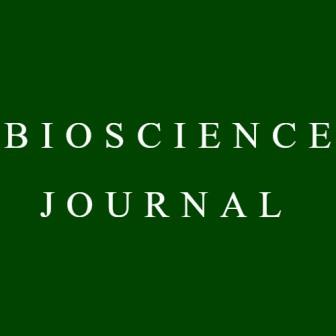Association between TSH status and prevalence of miscarriages and stillbirth
DOI:
https://doi.org/10.14393/BJ-v37n0a2021-53854Palavras-chave:
Hypo-/hyperthyroidism, Iodine Intake, IUD, Pregnant Females, TSH.Resumo
Thyroid hormones play a significant role in normal human body growth. Abnormalities in thyroid stimulating hormone (TSH) levels can result in pregnancy loss due to miscarriages and intrauterine death (IUD). The objective of the study was to assess the levels of association of thyroid stimulating hormone with miscarriages and IUD. The descriptive study involving 110 samples between 18-40 years of age fulfilling inclusion criteria were sampled for TSH testing (2ml blood) after attaining their written informed consent. The mean age of participants was 29.49±4.26 year. The prevalence of hypothyroidism and hyperthyroidism was 3.64% and 2.73%, respectively. Complications like gestational hypertension, depression and oligomenorrhea were found prevalent in these females. Majority of females were taking high/low iodine than recommended iodine level (150mcg). This work shows that there is a significant association between pregnancy loss and disturbed TSH levels among pregnant females.
Downloads
Referências
ANDERSEN, S.L., et al. Maternal Thyroid Function in Early Pregnancy and Neuropsychological Performance of the Child at 5 Years of Age. The Journal of Clinical Endocrinology & Metabolism. 2018, 103(2), 660-670. https://doi.org/10.1210/jc.2017-02171
ANDERSEN, S.L., et al. Spontaneous abortion, stillbirth and hyperthyroidism: a danish population-based study. European Thyroid Journal. 2014, 3(3), 164-172. https://doi.org/10.1159/000365101
BLACK, M., SHETTY, A. and BHATTACHARYA, S. Obstetric outcomes subsequent to intrauterine death in the first pregnancy. BJOG: An International Journal of Obstetrics and Gynaecology. 2008, 115(2), 269-274. https://doi.org/10.1111/j.1471-0528.2007.01562.x
BIBAN, B.G. and LICHIARDOPOL, C. Iodine Deficiency, Still a Global Problem? Current Health Science Journal. 2017, 43(2), 103-111. https://doi.org/10.12865/CHSJ.43.02.01
BRENT, G.A. Mechanisms of thyroid hormone action. The Journal of Clinical Investigation. 2012, 122(9), 3035-3043. https://doi.org/10.1172/JCI60047
FEKI, M., et al. Thyroid disorders in pregnancy: frequency and association with selected diseases and obstetrical complications in Tunisian women. Clinical Biochemistry. 2008, 41(12), 927-931. https://doi.org/10.1016/j.clinbiochem.2008.05.002
HUANG, C. J., et al. Iodine nutritional status of pregnant women in an urban area of northern Taiwan in 2018 Iodine nutritional status of pregnant women in an urban area of northern Taiwan in 2018. PLOS ONE. 2020, 15(5), e0233162. https://doi.org/10.1371/journal.pone.0233162
GUI, J., XU, W. and ZHANG, J. Association between thyroid dysfunction and perinatal outcomes in women with gestational hypertension: a retrospective study. BMC Pregnancy Childbirth. 2020, 20(1), 1-9. https://doi.org/10.1186/s12884-020-2805-6
KHALID, A.S., JOYCE, C. and O’DONOGHUE, K. Prevalence of subclinical and undiagnosed overt hypothyroidism in a pregnancy loss clinic. Irish Medical Journal. 2013, 106(4), 107-110.
KOREVAAR, T.I.M. The upper limit for TSH during pregnancy: why we should stop using fixed limits of 2.5 or 3.0 mU/l. Thyroid Research. 2018, 11, 1-5. https://doi.org/10.1186/s13044-018-0048-7
KOULOURI, O., et al. Pitfalls in the measurement and interpretation of thyroid function tests. Best Practice & Research Clinical Endocrinology & Metabolism. 2013, 27(6), 745-762. https://doi.org/10.1016/j.beem. 2013.10.003
MARAKA, S., et al. Subclinical Hypothyroidism in Pregnancy: A Systematic Review and Meta-Analysis. Thyroid. 2016, 26(4), 580-590. https://doi.org/10.1089/thy.2015.0418
MARAKA, S., et al.. Thyroid hormone treatment among pregnant women with subclinical hypothyroidism: US national assessment. BMJ. 2017, 25(356), i6865. https://doi.org/10.1136/bmj.i6865
McELDUFF, A. and MORRIS, J. Thyroid function tests and thyroid autoantibodies in an unselected population of women undergoing first trimester screening for aneuploidy. Australian and New Zealand Journal of Obstetrics and Gynaecology. 2008, 48(5), 478-480. https://doi.org/10.1111/j.1479-828X.2008.00903.x
NAMBIAR, V., et al.. Prevalence and impact of thyroid disorders on maternal outcome in Asian-Indian pregnant women. Journal of Thyroid Research. 2011, 11(4), 87-94. https://doi.org/10.4061/2011/429097
NEGRO, R., SCHWARTZ, A. and STAGNARO-GREEN, A. Impact of levothyroxine in miscarriage and preterm delivery rates in first trimester thyroid antibody-positive women with TSH less than 2.5 mIU/L. The Journal of Clinical Endocrinology and Metabolism. 2016, 101(10), 3685-3690. https://doi.org/10.1210/jc.2016-1803
POPPE, K. and GLINOER, D. Thyroid autoimmunity and hypothyroidism before and during pregnancy. Human Reproduction Update. 2003, 9(2), 149-161. https://doi.org/10.1093/humupd/dmg012
SHEEHAN, M.T. Biochemical Testing of the Thyroid: TSH is the Best and, Oftentimes, Only Test Needed - A Review for Primary Care. Clinical Medicine Research. 2016, 14(2), 83-92. https://doi.org/10.3121/cmr.2016.1309
WANG, W., et al. The prevalence of thyroid disorders during early pregnancy in China: The benefits of universal screening in the first trimester of pregnancy. European Journal of Endocrinology. 2011, 164(2), 263-268. https://doi.org/10.1530/EJE-10-0660
WILSON, K.L., et al. Subclinical thyroid disease and the incidence of hypertension in pregnancy. Obstetrics and Gynecology. 2012, 119(2), 315-20. https://doi.org/10.1097/AOG.0b013e318240de6a
ZIMMERMANN, M.B. and BOELAERT, K. Iodine deficiency and thyroid disorders. The Lancet Diabetes and Endocrinology. 2015, 3(4), 286-95. https://doi.org/10.1016/S2213-8587(14)70225-6
Downloads
Publicado
Como Citar
Edição
Seção
Licença
Copyright (c) 2021 Afshan Kaleem, Rabail Javed, Kashmala Khalil, Mehwish Iqtedar, Roheena Abdullah, Lubna Riaz , Nadeem Ahmad, Farheen Aslam

Este trabalho está licenciado sob uma licença Creative Commons Attribution 4.0 International License.






